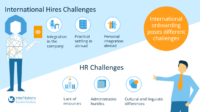Employees are valuing career development more than ever—it’s a sign that the company is willing to invest in their future. How are businesses approaching training today? What are their pain points, and what topics are being addressed in training?
A well-structured onboarding process is key to winning the hearts and minds of new employees. It not only defines a new hire’s first impression of a company but also influences his or her level of commitment to the new employer.
When it comes to employee training, it’s important to have a clear idea of what trainees are expected to gain from the training process. This could include specific skills—how to operate a forklift, how to complete the monthly accounting checkout, etc.—but it can, and should, also encourage the development of what some would call soft […]
One skill any great HR and people ops leader should have is being able to roll out information in a way that people notice it, remember it, and apply it. In the world of cognitive psychology, we call these attention, retention, and transfer skills.
Despite years of training across organizations in the United States, including a growing list of states where such training is mandated by law, sexual harassment still exists. The rise of the #MeToo movement has accentuated this exact problem: Sexual harassment is still rampant in the face of widespread training.
Employee training is a major activity in many organizations—and for good reason. Regardless of new hires’ credentials upon joining an organization, training helps ensure their work meets company standards and expectations.
For generations, parents have told their children one of the most important ways they can help themselves succeed in life is to go to school and get a degree. But a college degree alone often isn’t enough for many students anymore.
It’s hard enough finding new employees with the potential to excel in an organization’s work environment. But on top of the basic recruitment, employees also need to be trained and kept engaged to ensure they can perform to their full ability—and that they will remain productive.
While many in the workforce fear the potential of being displaced by new technologies like artificial intelligence (AI), companies around the globe are actually seeing a need for more workers with advanced skills to manage the use of AI and other technologies.
In earlier centuries, apprenticeships were the norm for introduction into a profession. What better way to learn a trade than to be immersed in that trade under the tutelage of an experienced practitioner?
When a workplace lacks civility, it creates fear, anxiety, a lack of transparency, and the whole place descends into a dark place. Our guest in this episode of HR Works specializes in workplace civility training. Colleen Passard is a writer, mediator and coach. She has a Masters in Humanistic Counseling Psychology and is certified in […]













